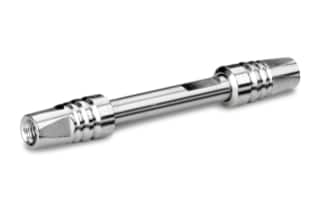
|
Chemistry |
Phenyl |
|
Separation Mode |
Reversed Phase |
|
Particle Substrate |
Hybrid |
|
pH Range Min |
1 pH |
|
pH Range Max |
12 pH |
|
Maximum Pressure |
18000 psi (1240 Bar) |
|
Endcapped |
Yes |
|
Bonding Technology |
Phenyl-Hexyl |
|
Silanol Activity |
Low |
|
Particle Shape |
Spherical |
|
Particle Size |
1.7 µm |
|
Endfitting Type |
Parker-style |
|
Pore Size |
130 Å |
|
Format |
Column |
|
Surface Area |
185 |
|
System |
UPLC, UHPLC |
|
Particle Technology |
BEH |
|
USP Classification |
L11 |
|
Inner Diameter |
2.1 mm |
|
Length |
50 mm |
|
Carbon Load |
15 % |
|
eCord |
Yes |
|
UNSPSC |
41115709 |
|
Brand |
ACQUITY UPLC |
|
Product Type |
Columns |
|
Units per Package |
3 pk |

ACQUITY UPLC BEH Phenyl Column, 130Å, 1.7 µm, 2.1 mm X 50 mm, 3/pk
Reversed-phase columns that contain phenyl-ligand are a top choice for chromatographers who need selectivities complementary to other straight-chain-alkyl stationary phases. However, these ligands traditionally have had disadvantages, including poor pH stability, reproducibility, and peak shape. The ACQUITY UPLC BEH Phenyl Column has been designed to overcome these challenges, providing complementary selectivities, excellent pH stability, and superior peak shape across compounds with one piece of lab equipment.
ACQUITY UPLC BEH Phenyl Columns use a trifunctional C6-alkyl tether between the phenyl ring and the silyl functionality. Combining this phenyl-hexyl ligand with a proprietary end-capping process allows for chromatographers to experience ultra-low column bleed, long column lifetimes, and superior peak shape. This innovative blend of ligand, end-cap, and 1.7 µm BEH particles allows for new levels of selectivity and efficiency in UPLC separations that were once more challenging.
Along with these rugged and efficient stationary phases, ACQUITY UPLC BEH Phenyl Columns have been designed to offer the longest possible lifetime in columns in UPLC conditions. The improved column hardware minimizes band broadening and ensures a connection without leaks, along with a frit design that keeps particles in the column, not the detector or the MS source. Along with the proprietary column-packing station and process, these innovative designs guarantee a stable packed column bed and long, reproducible column lifetime.
All columns are manufactured under strict processes to ensure reproducibility year over year. ACQUITY UPLC BEH Phenyl Columns are chromatographically tested in facilities compliant with industry regulation, and further testing can be performed using a Neutrals QC Reference Material from Waters.
How Should I Clean My ACQUITY UPLC BEH Phenyl Column?
Contamination of the column may be present if you notice changes in peak shape, peak splitting, shoulders on the peak, shifts in retention, changes in resolution, or increasing backpressure. If this occurs, flush your column with a neat organic solvent and take care not to precipitate buffers. If this does not solve the problem, you will need to purge the column. Purging should always be done using a routine that matches the properties of your samples and/or what you believe is contaminating the column. If performance remains poor after purging, call your local Waters office for continued support.